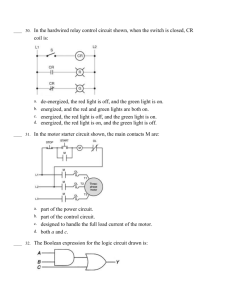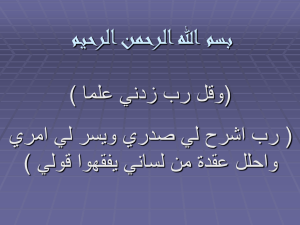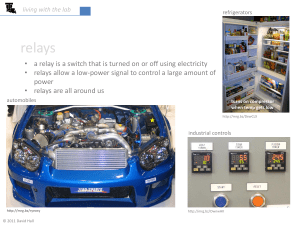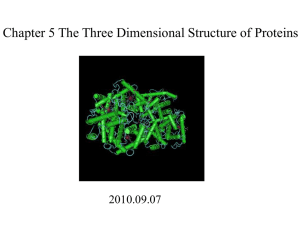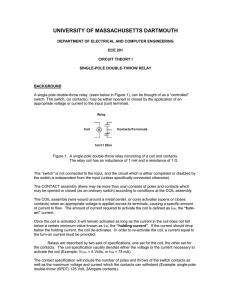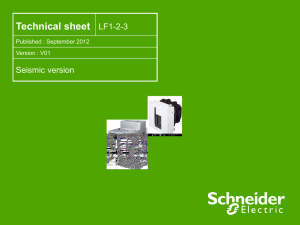Elec467 Power Machines & Transformers
advertisement
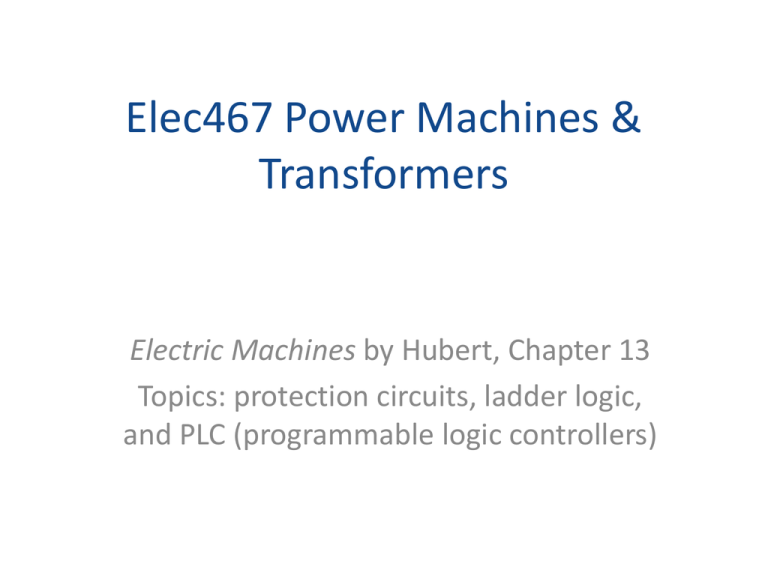
Elec467 Power Machines & Transformers Electric Machines by Hubert, Chapter 13 Topics: protection circuits, ladder logic, and PLC (programmable logic controllers) Contactor A contactor makes and breaks power circuits. Because sparks are associated with live circuits and motors draw large currents, sparking is an issue which is dealt with by use of a blow-out coil. Other constructions minimize the time the stays in contact with the actual contacts. How a blow-out chute works When the circuit breaks a spark is created. This spark is actually a current flow of electrons jumping through the air because of the potential difference. The current is changed into a magnetic field by the blow-out coil which affects the path of the current which is not restrained by a wire. As the length of the spark grows the resistance increases eventually causing the flow of electrons to stop. Shading coil The shading coil changes the flux across the contacts so that the armature doesn’t chatter when the operating coil closes. Chatter is created when the armature closes so quickly it bounces off the stationary contact. The shade coil is wrapped around ½ of the flux path so the current flow created in the shade coil creates a counter emf flux. This delays a portion of the flux created by the operating coil when it is turned on. Once the flux stabilizes the shade coil field collapses. The initial flux which caused the armature to change states (closing) is not strong enough to hold the armature closed without bouncing. This is when the flux delayed by the shade coil shows up in time to hold the armature closed and not allow it to bounce. Thermal overload relay The Thermal overload relay operates somewhat like a thermocouple but uses different coefficients of expansion properties of two dissimilar metal to pull contacts apart when there is too much current causing the heater element to overheat. . Schematic showing operation of thermal overload relay There is a range of currents that cause the relay to open (trip) and a delay time to allow the motor to cool before it can be reset. Over-current relay An over-current relay is designed so a high current flow will cause the contacts to open. This is a normally closed relay under normal current flow. Its placement in the motor branch circuit breaks the circuit and the relay holding the M contacts closed opens when they lose power. The over-current relay loses power also but by then its job is done. A motor circuit diagram shows connections labels, wiring and physical placement. This is a ladder network. The rungs of the ladder are branches of circuits wired in parallel. It reads top to bottom, left to right. Normal arrangement has the functional circuit on the first rung and subsequent branches control relays above their rung. PLC software facilitates the design of a control circuit. Automatic circuit breakers This slide illustrates two types of button designs. (a) is a forever Start and you have to press Stop to break the contact. (b) is a Start that stays connected until the voltage drops or the Stop button interrupts the voltage. Both stop the motor when M’s operation coil looses power causing the flux to collapse that was holding M’s contacts closed Programmable Logic Controllers PLCs are used to control machines or processes that are sequential in nature, using “discrete” inputs and outputs that have defined states. For example, if a limit switch detects the presence of an object, it provides an “ON” signal to the PLC; if no object is detected, it provides an “OFF” signal. The machine or device typically performs actions based on time or events in a pre-defined order. PLC basics A PLC consists of three basic sections: power supply, the central processing unit (CPU) and the input/output interface system. The CPU, which controls all PLC activity, can further be broken down into the processor and memory system. The input/output system is physically connected to field devices (e.g., switches, sensors, etc.) and provides the interface between the CPU and the information providers (inputs) and controllable devices (outputs). One of many optional I/O units Power supply CPU with I/O
